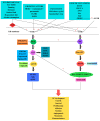Targeting PI3K/AKT/mTOR and MAPK Signaling Pathways in Gastric Cancer
- PMID: 38339127
- PMCID: PMC10856016
- DOI: 10.3390/ijms25031848
Targeting PI3K/AKT/mTOR and MAPK Signaling Pathways in Gastric Cancer
Abstract
Gastric cancer (GC) is the fourth leading cause of death worldwide, with more than 1 million cases diagnosed every year. Helicobacter pylori represents the main risk factor, being responsible for 78% of the cases. Increased amounts of salt, pickled food, red meat, alcohol, smoked food, and refined sugars negatively affect the stomach wall, contributing to GC development. Several gene mutations, including PIK3CA, TP53, ARID1A, CDH1, Ras, Raf, and ERBB3 are encountered in GC pathogenesis, leading to phosphatidylinositol 3-kinase (PI3K) protein kinase B (AKT)/mammalian target of rapamycin (mTOR)-PI3K/AKT/mTOR-and mitogen-activated protein kinase (MAPK) signaling pathway activation and promoting tumoral activity. Helicobacter pylori, growth factors, cytokines, hormones, and oxidative stress also activate both pathways, enhancing GC development. In clinical trials, promising results have come from monoclonal antibodies such as trastuzumab and ramucirumab. Dual inhibitors targeting the PI3K/AKT/mTOR and MAPK signaling pathways were used in vitro studies, also with promising results. The main aim of this review is to present GC incidence and risk factors and the dysregulations of the two protein kinase complexes together with their specific inhibitors.
Keywords: MAPK; PI3K/AKT/mTOR; bacterial infection; dysregulation; gastric cancer; gene mutations; inhibitors.
Conflict of interest statement
The authors declare no conflicts of interest.
Figures


References
-
- Bai D., Xiang W., Chen X., Hu J. Risk factors of postoperative pulmonary infection of gastric cancer and perioperative intervention measures. Zhonghua Wei Chang. Wai Ke Za Zhi = Chin. J. Gastrointest. Surg. 2021;24:185–190. - PubMed
Publication types
MeSH terms
Substances
LinkOut - more resources
Full Text Sources
Medical
Research Materials
Miscellaneous

